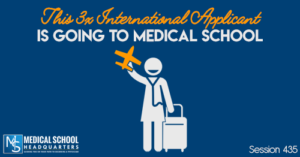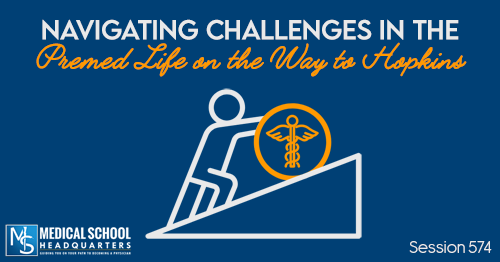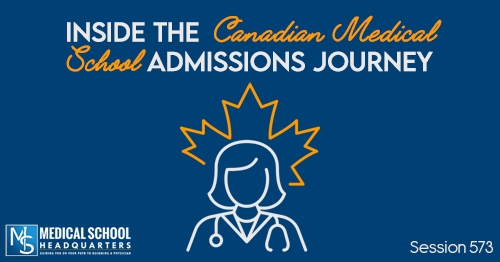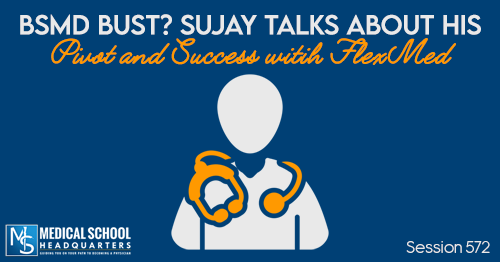Apple Podcasts | Google Podcasts
Session 435
Lydiah is an international student from Kenya who was accepted into a U.S. med school. For someone raised in the slums on the outskirts of Nairobi, Kenya, how did she end up in the United States with an acceptance to medical school here in the United States? Today, we talk all about her struggles, determination, and successes!
For more podcast resources to help you along your journey to medical school and beyond, check out Meded Media.
Listen to this podcast episode with the player above, or keep reading for the highlights and takeaway points.
[02:32] A Peek Into Lydiah’s Journey
Living in the slums in Nairobi, Lydiah got exposed to people who are sick within the community through a community outreach program. These are women and the youth suffering from the HIV and AIDS epidemic in Kenya.
At that time, there was a lot of stigma surrounding HIV and anybody who took the antiretrovirals. And so, as a church community, they felt they needed to remind the sick that people cared for them.
During those home visits or community visits, she got introduced to healthcare. And the more they visited with their community members, the more she felt she wanted to be there with them. And through that, her interest grew even more.
She then decided to start volunteering with a program called the Heritage Kenya Organization (HEKO), which also ministers to people with HIV and AIDS. It was also through the same organization that she got the opportunity to go and volunteer at the Kenyatta National Hospital, a level five Hospital in Nairobi, Kenya.
Through this volunteering experience, she got inspired by the patients that she was convinced she had to do something to be there for the patients. One of the patients there who was suffering from tuberculosis secondary to HIV AIDS was abandoned by her family. And she wished she could have done something to help her.
Because of the patient’s condition, she wanted to learn more to understand what was going on with her. And that was her initial introduction to patient care within a clinical setting. Along this journey, as well, she met a physician who saved her life when her mom almost miscarried her, which also increased her interest in healthcare and medicine in general.
“You don't have to grow up in the slums to be from a disadvantaged background… we have plenty of disadvantaged backgrounds and areas here in the United States.'Click To TweetLydiah credits her parents as a source of her confidence, as she grew up seeing them volunteering in the community and sometimes sharing the very little food they had. They spent a lot of time in the church and in the community, just extending a helping hand to members of their church and their community. And so, she was actively involved in the church and through the church. Basically, this became a culture or a way of life for her and her family.
[07:35] Her Journey to the U.S.
In Kenya, they have a standardized exam for 12th graders that determines which University you go to and what kind of major you could pursue there. It was during that time that Lydiah was beginning to learn more about the different opportunities for higher education.
She also got to learn more about the education system in Kenya, which is very good. However, she knew her parents would not afford to take her to a private institution. And that meant she was most likely to end up in a government institution. Add that to the countless strikes happening around the country, she knew she wouldn’t want to pursue her education in Kenya. She wanted to do it outside the country, not particularly in the U.S., but just in one of the developed countries – but Kenya.
She then started doing research on how to study in a different country, considering the financial constraints until she came across an organization called the Zawadi Africa Education Fund. It’s a leadership program that focuses on getting opportunities for females who have overcome insurmountable odds to achieve academic excellence. The organization helps them apply to schools with different partnering institutions in Canada, the U.S., and in some countries in Africa as well.
When she got the phone call, she had already started attending a university in Kenya, pursuing electrical and communication engineering. And Zawadi Africa told her she got accepted to Roanoke College. At that point, she cried because she knew her life would turn around completely.
[11:52] The Learning Curving Coming to the United States
When she moved in 2012, the college community at Roanoke was very supportive of her and they helped her transition. She was confident she could speak English since it was a predominant language in Kenya but communicating was still a challenge for her due to her accent. People didn’t understand her very well but she took this positively.
'It was still very challenging because sometimes you can feel inadequate.'Click To TweetLydiah had a full-ride scholarship but she still had personal things to take care of. Being new, she couldn’t be allowed to work more than 20 hours a week. And so, finances were challenging. She didn’t drive.
That being said, she went to boarding school when she was younger so she was already used to being alone and figuring out things on her own. And this helped her through the transition as well as just taking things one day at a time and staying focused.
At the back of her mind, she knew she wanted to pursue medicine. Unfortunately, when they were being prepared to transition from Kenya to the U.S., the lady discouraged them if they were thinking of pursuing medicine telling them it was going to be very challenging.
Although she felt discouraged, she still knew that she was going to make it one day. In Kenya, you pursue medicine as an undergraduate, not a graduate degree. And this is most likely the case in many countries.
So she thought of using the undergraduate to learn more about the environmental condition, growing up in the slums for which the environmental conditions are terrible. They are actually the major driving factor of poor health within the slums due to the lack of basic sanitation and hygiene. So her interest grew to learn more to get a better understanding of how things work together.
This then led her to pursue a major in environmental studies and then she majored in biology. Because most of her premed prerequisites were leading to a biology degree. So she decided to pursue both of them.
[15:39] Undergrad Struggles and Applying to Med School
The number one struggle she had was her finances. She was pursuing two majors with a minor in Chemistry. And then she had to work and pursue research.
She found herself not enjoying undergraduate as much as she would have wanted to. But overall, her experience at Roanoke was one of her most meaningful experiences, because she took advantage of opportunities presented to her.
It was during her junior year of college when she applied to medical school for the first time. And at the time, she actually thought she knew what she was doing. But then looking back, she really had no idea because nobody in her family was ever in the medical field. So she didn’t really understand the gravity of what it takes to get into medical school, except that she was forewarned about it before coming to the U.S. And so, not getting a good MCAT score was a big blow to her.
Lydiah thinks the reason she didn’t get into medical school the first time was both her poor MCAT score and her essays. She didn’t think she did a good job telling her story because she was focused on selling herself. She was like reciting her resume in paragraphs.
'I don't think I did a good job at telling my story because I was so focused on selling myself. It was like I was reciting my resume in paragraphs.'Click To TweetIn order to prepare for her application the second time, she was mostly reflecting back on what she had been doing the first time. First off, she only applied to five schools. And out of all those, nothing offered any feedback as to why she didn’t get in.
At that point, she was an international student with an F1 visa. And that may have probably contributed to not getting in as well. Because it just makes things even harder being an international student.
Now, the good thing about having an F1 student visa is that you’re allowed up to two years of internship. You’re allowed to work only for an employer or you’re allowed to do a job that is directly related to your major. So at least that gave her some hope that even after she graduated from college, she could still work while she’s still trying to figure herself out and what to do next. All she knew was that she was going to reapply to medical school.
[21:20] A Desire to Become a U.S. Citizen
At the same time, they also had a military army recruiter come to campus and told them about the military and how they could get naturalized and become a U.S. citizen.
Her family is still in Kenya. And having mentioned that her college was one of her most meaningful experiences so far, she felt she needed to give back. So at the time when the army recruiter came, and he talked about the military, and how they can serve in different ways and get citizenship, she didn’t even think twice. She just felt convicted to sign up and enlist in the U.S. Army.
Through the Health Professions Scholarship Program, she could go to medical school. They’re going to pay for everything, and in return, she could work for the military. So they use that to encourage her to enlist with their recruiting commander.
The idea of serving the military was not entirely new to her as well since her grandfather served in the military in Kenya back in World War II. Her mom was also enrolled to what’s equivalent to the U.S. national guard.
[24:50] Applying to Medical School the 2nd Time
Lydiah first applied to medical school in 2015, then she graduated from undergrad in 2016 and also joined the military in 2016. Then she felt she was ready to apply the second time in 2018. She began writing her essays and asked her family and friends to edit her essays.
Lydiah tried to stick to her story as much as possible. But she got so much feedback that she remembers feeling so confused. She was just over-stressing herself. And looking back, she thought she would not have done this.
Her initial MCAT score in 2015 was 495. And then when she retook it in 2018, she got a 498. And she still went ahead and submitted her application with a village essay. And she was not accepted to any school nor did she get an interview with any of the 16 schools she applied to. And at that point, she still wasn’t a U.S. citizen.
[28:36] A New Sense of Hope
Driving back home from the airport, she remembers listening to this podcast where I was talking about not giving up. And this was an episode featuring one of those accepted students where they shared their challenges. Lydiah was able to relate to their story and this gave her hope.
And so, she was committed to applying again and now, knowing she has a new resource to go to through this podcast. Then every time she drove or she was home cleaning, she would listen to every single podcast that she had not listened to before that time.
Having majored in environmental studies, she did an internship and she didn’t really like it. And at the same time, she was also working as a scribe in the emergency department. She had a perfect schedule from eight to five, and she was free over the weekend. Plus, they paid her well. And she found that any time she was working in the, she felt she belonged. But she went to work with an environmental job, she just felt out of place completely out of place. Then she also continued volunteering and shadowing physicians.
So it was not just the podcast, although it also served to remind her or to encourage her that she could still do it whenever challenges arise. She learned about how many people would apply multiple times, and they still get in eventually, if you persisted. She could still do it and her life experiences made her realize that.
Also, before going to Kenya, she had retaken the MCAT and scored a 491, which was seven points down from the last time. And that was because she rushed it. She took it a month after her previous score so she obviously didn’t have enough time to prepare. She was also taking it with a lot of stress, putting too much pressure on herself – of not wanting to be late and wanting to get in.
After coming back to Kenya and listening to the podcast, Lydiah reached out to me and asked me to go on this journey with her. And it’s not to say that my way is the only way but it’s the way that I think really tells a story, and compared to her original essays, it was just night and day.
Interestingly, Lydia was paid to teach people how to write essays as an undergrad. And she realized it just takes a different way of thinking or telling your story for other people to understand.
[34:33] Applying the 3rd Time
With MCAT scores from 495 to 498 to 491, she knew she had to do something to improve. Obviously, she studied longer than the last time, spending about four months studying for the MCAT, which she took in January 2020. And when the score came back, she got a 499. Ideally, you want to be at a 500, but Lydiah decided to push forward with her application.
So this was her third application cycle and her fourth MCAT. She admits she had moments when she would just sit down and ask herself what else she can do. That being said, she never doubted she wanted to practice medicine, especially with all her life experiences. While she continued working at the cancer center interacting with patients and different physicians, she kept on asking herself what could still be done differently.
Finally, when she got the first interview invitation, she was elated and felt humbled. Getting an interview invitation to medical school was truly a big deal for her.
[40:03] What the Future Holds for Lydiah
Going to medical school, Lydiah is keeping an open mind because she knows it could still change as she gets more exposed and learns more about medicine. But as of now, she’s thinking about pursuing emergency medicine, having spent almost three years working as a scribe.
She could also see herself doing mission medicine, both locally and globally, in different parts of the world in underserved communities.
Moreover, there’s a lot of unfounded fear around needing to take the MCAT multiple times and that they need to apply multiple times. And at the end of the day, if you get that interview, the schools understand that this is a long, hard journey for a lot of students. Especially being an immigrant to this country, English is on the side burner, which is unusual for a lot of immigrants.
Hopefully, this has encouraged and motivated all of our students out there that if this is what you want, no matter if it takes and this is what you want to do, then do it.
[43:40] The MCAT Minute
This is sponsored by Blueprint MCAT. If you need to take the MCAT in June because that’s going to be the best time for you, then you can do that. Ideally, you still apply before the MCAT. But if you need to wait to apply, that will hurt.
But if you need to take the MCAT a little bit later, apply before you take the MCAT to one school so that you can submit your application. That way, when you get your MCAT score back, you can add more schools to your list. and then submit those secondaries as soon as possible.
If you want some amazing free MCAT resources, check out The MCAT Podcast, which we also have in collaboration with Blueprint. Then go to their website and sign up for a free account. You’ll get free access to their half-length diagnostic, their full-length one as well as an amazing study and planner.












